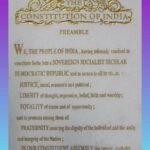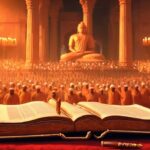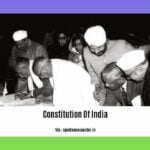The Fascinating Facts About the Indian Constitution Explained in English will take you on a journey through one of the most comprehensive and unique constitutional documents in the world. From its inception in 1950, the Indian Constitution has stood as a testament to the ideals of justice, equality, and freedom. In this article, we will unravel the lesser-known facts and intriguing facets of this remarkable constitution, shedding light on its historical significance and its impact on the nation and its people.
Key Takeaways:
- The Indian Constitution is the longest constitution in the world, consisting of a Preamble, 22 parts, 448 articles, 12 schedules, 5 appendices, and 115 amendments.
- The original handwritten copies of the Indian Constitution were done by calligrapher Prem Behari Narain Raizada, with each page being embellished by artists such as Nandalal Bose and Beohar Rammanohar Sinha.
- The Indian Constitution is often described as ‘a bag of borrowings’ as it draws elements from various sources, including other constitutions.
- In terms of word count, the Indian Constitution contains approximately 146,000 words.
- The right to vote for citizens of India was only granted after the enforcement of the Indian Constitution.
- The Constitution of India serves as a code of conduct and outlines the rights of all Indian citizens.
- The Constitution encompasses 444 articles, 22 parts, 12 schedules, and 115 amendments, making it the longest written constitution in the world.
- Rather than being printed or typed, the Indian Constitution was entirely handwritten.
- The Constituent Assembly, responsible for drafting the Indian Constitution, began its deliberations in December 1946.
- The Constitution was finalized after a rigorous process of debates, discussions, and amendments.
- The Indian Constitution establishes a federal structure with provisions for both central and state governments.
- The enforcement of the Indian Constitution represented a significant milestone in the democratic history of the country.
Facts About the Indian Constitution in English

The Indian Constitution is a remarkable document filled with fascinating facts that define the rights and duties of Indian citizens. In this article, we will explore some of the key facts about the Indian Constitution, providing you with valuable insights into this monumental piece of legislation.
1. The Longest Constitution in the World
Did you know that the Indian Constitution holds the prestigious title of being the longest constitution in the world? With its comprehensive nature, it contains a staggering number of components, including a Preamble, 22 parts, 448 articles, 12 schedules, 5 appendices, and 115 amendments. Its sheer size reflects the depth and complexity of the principles and values it upholds[^1^].
2. Exquisite Artistry
The beauty of the Indian Constitution lies not only in its words but also in its appearance. The original copies of the Constitution were handwritten by the talented calligrapher Prem Behari Narain Raizada in both Hindi and English. To add an artistic touch, renowned artists like Nandalal Bose and Beohar Rammanohar Sinha adorned each page with their exquisite designs[^1^][^2^].
3. A Tapestry of Borrowings
The Indian Constitution is often described as ‘a bag of borrowings.’ It draws inspiration from a variety of sources, including other constitutions. By incorporating elements from diverse legal systems, the Indian Constitution reflects a careful selection of ideas that best suit the needs and aspirations of the Indian people[^2^].
4. Word Count Wonder
If you were to count every word in the Indian Constitution, you’d be astonished to find approximately 1.46 lakh (146,000) words. This extensive word count underscores the comprehensive nature of the constitution, ensuring that it covers a wide range of issues relevant to building a just and inclusive society[^2^].
5. A Landmark for Democracy
One of the most significant milestones in Indian history was the enforcement of the Indian Constitution. It granted the citizens of India the right to vote, laying the foundation for a vibrant and inclusive democracy. This empowering development transformed the way Indians could participate in shaping their nation’s destiny[^2^].
6. Code of Conduct and Citizen Rights
The Constitution of India serves as a guiding light, defining the code of conduct and protecting the rights of all Indian citizens. It sets the framework for government functioning, ensuring that individuals are free to express themselves, practice their chosen religion, and enjoy equal protection under the law[^3^].
7. Deliberate Deliberations
Drafting the Indian Constitution was a meticulous process that involved rigorous debates, discussions, and amendments. The Constituent Assembly, responsible for formulating this visionary document, commenced its deliberations in December 1946. This extensive and democratic process ensured that a wide range of perspectives and expertise were considered[^3^].
8. Federal Structure
India’s Constitution provides for a federal structure that balances power between the central government and the state governments. This arrangement allows states to have their own governance while ensuring a unified approach to national issues. It strikes a delicate balance between local autonomy and national cohesion[^1^].
9. Handcrafted Magnificence
Unlike most constitutions, the Indian Constitution was not printed or typed. Instead, it was entirely handwritten with meticulous care. Its pages stand as a testament to the painstaking efforts of the framers who painstakingly transcribed their vision for a just and progressive India[^1^][^3^].
The Indian Constitution is a marvel of legal thought, establishing the principles and values that guide the world’s largest democracy. Its rich tapestry of ideas, comprehensive coverage, and historical significance make it a document of great importance. By understanding the facts about the Indian Constitution, we can appreciate the wisdom that went into shaping the destiny of a nation.
Do you want to learn more about the Indian Constitution? Check out the table below for a quick overview of its key features.
| Title | Details |
|---|---|
| Preamble | Provides a concise overview of the constitution’s guiding principles |
| Parts | Divisions within the constitution addressing different topics |
| Articles | Specific provisions elucidating various rights, duties, and governmental functions |
| Schedules | Appendices containing additional details and rules |
| Amendments | Modifications made to the original constitution over time |
Each of these elements adds depth and clarity to the Indian Constitution, ensuring it remains a living document that adapts to the evolving needs of its people[^1^][^4^].
Engaging and enlightening, the Indian Constitution stands as a testament to the collective wisdom of its framers. By delving into the facts about the Indian Constitution, we can gain a deeper understanding of the principles that govern our nation and the rights that empower its citizens.
Here are some interesting links to explore:
- Facts about 9/11 Memorial: Discover surprising and little-known facts about the iconic 9/11 Memorial.
- Facts about Indian Constitution: Delve into the intriguing details and lesser-known facts about the Indian Constitution.
- Few lines about Indian Flag in Kannada: Explore a brief and captivating write-up about the Indian Flag in the Kannada language.
Fundamental Rights and Duties of Indian Citizens
The Indian Constitution grants its citizens a set of fundamental rights and duties that serve as the cornerstone of the country’s legal system. These fundamental rights ensure the protection of individual liberties and prevent the State from encroaching upon them. On the other hand, fundamental duties outline the responsibilities of Indian citizens towards their country and fellow citizens.
Fundamental Rights
The Constitution of India includes seven main fundamental rights, which are enshrined in Articles 12-35. These rights guarantee civil liberties and empower citizens to participate in the democratic process. Here are the key fundamental rights recognized by the Indian Constitution:
Right to Equality: This right ensures that all individuals are treated equally before the law. It prohibits discrimination based on religion, race, caste, sex, or place of birth.
Right to Freedom: This right guarantees individual freedoms such as freedom of speech, expression, assembly, and association. It also protects the freedom to practice any religion and move freely throughout the country.
Right against Exploitation: The Constitution prohibits practices such as forced labor, trafficking, and child labor. It also prohibits the employment of children in hazardous occupations.
Right to Freedom of Religion: This right allows individuals to practice and propagate any religion of their choice. It ensures freedom of conscience and protects religious institutions.
Cultural and Educational Rights: These rights empower citizens to protect their culture, language, and heritage. They also provide minority groups with the right to establish and administer educational institutions.
Right to Constitutional Remedies: This right enables individuals to seek legal remedies if their fundamental rights are violated. It ensures access to justice and upholds the rule of law.
Fundamental Duties
The concept of fundamental duties was added to the Indian Constitution in 1976 through the 42nd Constitution Amendment Act. These duties outline the responsibilities that citizens must fulfill towards their country. Article 51(A) of the Constitution specifies the list of fundamental duties, which include:
- To abide by the Constitution and respect its ideals and institutions.
- To uphold and protect the sovereignty, unity, and integrity of India.
- To promote harmony and the spirit of common brotherhood among all citizens.
- To defend the country and render national service when required.
- To promote the values of democracy, socialism, and secularism.
- To safeguard public property and abjure violence.
- To strive towards excellence in all spheres of individual and collective activity.
- To protect and improve the natural environment.
- To cherish and follow the noble ideals that inspired India’s freedom struggle.
- To provide opportunities for education to children and ensure their well-being.
Key Takeaways:

- The Indian Constitution grants citizens fundamental rights and duties.
- Fundamental rights ensure the protection of individual liberties.
- The Constitution includes seven main fundamental rights, covering areas such as equality, freedom, and religion.
- Fundamental duties outline the responsibilities of Indian citizens towards their country and fellow citizens.
- Citizens must abide by the Constitution, uphold national unity, promote harmony, and protect public property, among other obligations.
For more information on fundamental rights and duties, you can refer to the following sources:
– BYJU’S article on Fundamental Rights and Fundamental Duties
– Hindustan Times article on Fundamental Rights and Duties of Every Indian
Role and Powers of the President, Prime Minister, and Parliament
The Indian Constitution lays out a complex web of powers and responsibilities for the President, Prime Minister, and Parliament. Understanding these roles is crucial to understanding the functioning of the Indian government. In this article, we will explore the key facts about the role and powers of the President, Prime Minister, and Parliament.
The President of India: Powers and Responsibilities
The President of India holds significant powers and responsibilities in the country. Here are the key points regarding the powers and responsibilities of the President:
Appointing Powers and Duties of the President
- The President has the power and responsibility to appoint the Prime Minister of India[^1^].
- The President of India appoints the Chief Justice[^1^].
- The President has the power to nominate 12 members to the Rajya Sabha, the upper house of the Parliament[^1^].
Legislative Powers Enjoyed by the President of India
- The President has the power to dissolve the Lok Sabha, the lower house of the Parliament[^1^].
- A bill that has been passed by both the houses of the Parliament can become a law only if it receives the President’s approval[^1^].
- The President of India has the power to nominate two members to the Lok Sabha, the lower house of the Parliament[^1^].
Military Powers of the President
- The President of India serves as the commander in chief of all the Indian armed forces[^1^].
- The President has the power to declare war or conclude peace with any country[^1^].
- All treaties with foreign countries are signed in the name of the President[^1^].
Executive Power Enjoyed by the President of India
- The President holds the executive powers of the country[^1^].
- The Parliament can grant additional powers to the President if it deems fit, and these powers can also be further delegated by the President to state governors[^1^].
Power to Pardon
- The President of India has the power to grant pardons, especially for crimes that are offenses against union law or granted by the military court[^1^].
These powers and responsibilities highlight the crucial role that the President of India plays in the country’s governance.
The Prime Minister of India: Powers and Responsibilities
The Prime Minister of India is the head of government and plays a key role in the functioning of the country. Here are the key points regarding the powers and responsibilities of the Prime Minister:
Appointment and Leadership
- The President of India appoints the Prime Minister[^1^].
- The Prime Minister is the leader of the Council of Ministers and is responsible for the overall governance of the country[^1^].
- The Prime Minister provides assistance and advice to the President in the exercise of his powers and duties[^1^].
Legislative Powers
- The Prime Minister is a member of the Lok Sabha, the lower house of the Parliament[^1^].
- The Prime Minister has the power to introduce and pass bills in the Parliament[^1^].
- The Prime Minister is responsible for making policy decisions and overseeing the implementation of laws[^1^].
Executive Powers
- The Prime Minister exercises executive powers and is responsible for the day-to-day administration of the government[^1^].
- The Prime Minister is the chief spokesperson for the government and represents India on various national and international platforms[^1^].
The Parliament: Role and Powers
The Parliament is the supreme legislative body of India and plays a crucial role in making and passing laws. Here are the key points regarding the role and powers of the Parliament:
Lawmaking
- The Parliament is responsible for making and passing laws in the country[^1^].
- It consists of two houses: the Lok Sabha (the lower house) and the Rajya Sabha (the upper house)[^1^].
- Both houses of the Parliament have the power to introduce and pass bills, which then become laws[^1^].
Scrutiny and Oversight
- The Parliament plays a crucial role in scrutinizing and overseeing the functioning of the government[^1^].
- It can question the government ministers and hold them accountable for their actions[^1^].
- The Parliament has the power to summon and investigate individuals and committees as part of its oversight function[^1^].
Budget Approval
- The Parliament approves the annual budget presented by the government[^1^].
- It scrutinizes and debates the budget proposals before giving its approval[^1^].
Constitutional Amendments
- The Parliament has the power to amend the Indian Constitution[^1^].
- Constitutional amendments require a special majority in both houses of the Parliament[^1^].
These are some of the key powers and responsibilities of the President, Prime Minister, and Parliament in India’s government structure.
Key Takeaways:
- The President of India has the power to appoint the Prime Minister, Chief Justice, and nominate members to the Rajya Sabha and Lok Sabha.
- The President serves as the commander in chief of the armed forces.
- The Prime Minister is the head of government and exercises executive and legislative powers, including introducing and passing bills.
- The Parliament has the power to make and pass laws, scrutinize the government, approve the budget, and amend the constitution.
Sources:
[^1^]: The President of India: Powers and Responsibilities
Process of Amending the Indian Constitution
The Indian Constitution is a dynamic document that can be amended to reflect the changing needs and aspirations of the country. The process of amending the Indian Constitution is crucial to maintaining its relevance and upholding the principles of democracy. In this article, we will explore the process of amending the Indian Constitution, shedding light on its significance and limitations.
Understanding the Importance of Constitutional Amendments
Amending the Constitution of India allows for the modification of its provisions, ensuring that it remains a living document capable of addressing the evolving needs of the nation. The process of amendment is outlined in Article 368 of the Constitution, which sets forth the guidelines for making changes to the supreme law of the land.
The Process of Amending the Indian Constitution
The process of amending the Indian Constitution involves the following steps:
Initiation of Amendment: The amendment process can be initiated by either house of Parliament, which includes the Lok Sabha (lower house) or the Rajya Sabha (upper house). The proposed amendment must be introduced as a Bill.
Passage by Parliament: The Bill must be passed by a majority of the total membership of each house, as well as a two-thirds majority of the members present and voting.
Presidential Assent: Once the Bill is passed by both houses of Parliament, it is then presented to the President for their assent. The President has the power to either give their assent or withhold it.
State Ratification: In certain cases, if the proposed amendment affects the federal structure or the powers of the states, it must be ratified by at least half of the state legislatures before it can come into effect.
Limitations on the Amending Power
While the Indian Constitution can be amended to adapt to changing circumstances, there are certain limits on the amending power to ensure the sanctity of the Constitution and prevent arbitrary changes. These limitations include:
Basic Structure Doctrine: The Supreme Court of India has held that certain fundamental features of the Constitution, such as secularism, democracy, and federalism, form part of its basic structure and cannot be amended.
Federalism: Amendments that affect the federal structure of the Constitution require the ratification of at least half of the state legislatures.
Fundamental Rights: Amendments that infringe upon the fundamental rights of citizens can be struck down by the judiciary if they are found to be unconstitutional.
Consent of the President: Certain amendments, such as those related to the powers and role of the President, require the assent of the President before they can be implemented.
Key Takeaways:
- Amending the Indian Constitution is the process of making changes to the nation’s fundamental law.
- The process is laid down in Article 368 of the Constitution.
- The amendment process ensures the sanctity of the Constitution and checks arbitrary power.
- Amendments require the passage of a Bill, presidential assent, and, in some cases, state ratification.
- There are limitations on the amending power to protect the Constitution’s basic structure, federalism, and fundamental rights.
Sources:
– InsightsIAS [^1^]
– ClearIAS [^2^]
[^1^]: InsightsIAS – Indian Constitution Amendments
[^2^]: ClearIAS – Indian Constitution Amendments
FAQ
Q1: How long is the Indian Constitution?
A1: The Indian Constitution is the longest constitution in the world, containing a Preamble, 22 parts with 448 articles, 12 schedules, 5 appendices, and 115 amendments.
Q2: Who handwritten the original copies of the Indian Constitution?
A2: The original copies of the Indian Constitution were handwritten in Hindi and English by calligrapher Prem Behari Narain Raizada.
Q3: What is the significance of the decorations in the handwritten Indian Constitution?
A3: Each page of the handwritten Indian Constitution was decorated by artists like Nandalal Bose and Beohar Rammanohar Sinha.
Q4: What are the key features of the Indian Constitution?
A4: The Indian Constitution is often referred to as ‘a bag of borrowings’ as it contains elements borrowed from various sources. It defines the code of conduct and the rights of all Indian citizens and provides for a federal structure with provisions for both the central and state governments.
Q5: What milestones were marked with the enforcement of the Indian Constitution?
A5: The enforcement of the Indian Constitution marked a significant milestone in the country’s democratic history. It granted the citizens of India the right to vote and solidified the democratic principles and rights of the people.
- SYBAU See You Baby Meaning: Gen Z Slang Evolves - July 1, 2025
- Unlock Your Inner Youth: Lifestyle Secrets for a Vibrant Life - July 1, 2025
- Decode SYBAU Meaning: Gen Z Slang Explained - July 1, 2025






